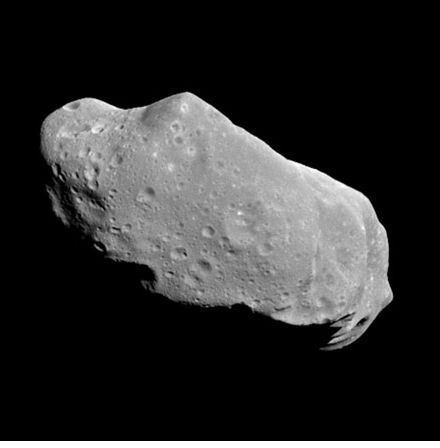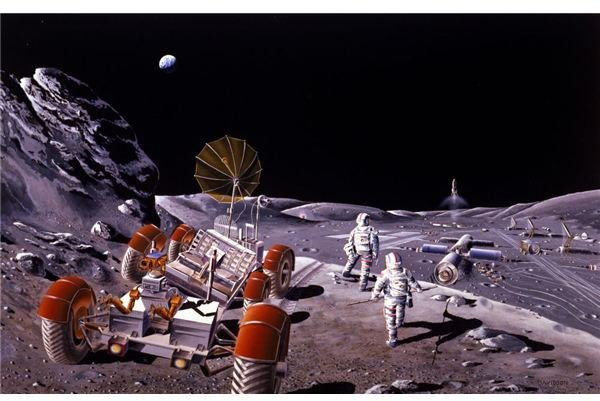Asteroid Mining - Science or Science Fiction?
Is There a Need?
For those who believe Earth’s population will continue to increase, the fear is manufacturers will have to pay more-and-more for less-and-less available raw materials. Not just Earth’s petroleum is used up. There is concern for metals and other resources as well. There are inner and outer asteroid belts in our Solar System. The inner belt is rich in metals. Is it possible space could be colonized and these inner asteroids could be “harvested” by workers in those colonies?
Artist’s Rendition: Colonizing (the Moon)
Image: NASA
Are Asteroids a Rich Resource?

Image: NASA (cropped)
There are thousands—perhaps millions—of asteroids within our Solar System. Of those, perhaps 20 percent are rich in metals such as iron, nickel and magnesium. Asteroids, if available, could certainly augment Earth’s supply of metals. According to John Lewis, author of Mining the Sky, an asteroid with a one kilometer diameter can contain 2 billion tons of mass, yielding more metal than has been mined in all human history. Would the opportunity to mine space rekindle the spirit of the Gold Rush? The promise of great wealth coupled with a desire to explore would certainly suggest so.
Target Asteroids
The asteroid belt lies between the orbits of Mars and Jupiter; it is here most asteroids are located. The closest approach between Earth and Mars is about 35 million miles, which is more than 1,500 times the distance between Earth and Moon. So, traveling beyond the orbit of Mars for a mining expedition would seem unfeasible—at least at first. Asteroids nearest the Earth (and in the metal-rich inner belt) would seem the ideal candidates for Man’s asteroid-mining initiative.
Technically, closeby asteroids (those that come within 1.3 astronomical units of the Sun) are categorized as Near Earth Objects (NEOs). NASA has been cataloguing asteroids that fall into this category since 1980. The objective of the search is to identify asteroids that pose the greatest risk to Earth. Of the 6,500 that have been identified so far, about 2,300 of them have a diameter greater than 300 meters. 800 have a diameter of one kilometer or greater.
On July 3, 2006 asteroid 2004 XP14, measuring 500 meters, came within 400,000 kilometers of our planet. Asteroids 2009DD45 and 2008TN166 approached Earth in 2009. The 30 meters wide 2009DD45 came within 70,000 kilometers of Earth. Asteroid Apophis, measuring 350 meters, is to approach Earth at a distance of about 36,000 kilometers in 2029.
Mining and Transportation Difficulties
Asteroids are quite small, and so possess little gravity. They have generally irregular surfaces. This would make mining difficult. New technologies would have to be develooped. Transportation of mined material would require transportation—some kind of shuttle device.
How could craft used in asteroid mining be powered? Besides water, asteroids contain ice. The ice can be melted and electrolyzed into its component parts (oxygen and hydrogen) by using solar power. These gases can then be used as fuel to drive the craft.
There is another difficulty: to simplify mining, rockets well-positioned rockets may be needed to eliminate or control the spinning of asteroid rotation.

Mining an Earth-Approaching Asteroid
Image: NASA (artist’s rendition)
Mining Methodologies
As a logical extension of the mining methods used on Earth, strip mining and tunneling could be applied to asteroid mining. Strip mining is the scraping of minerals from an asteroid’s surface; this technique would be best used in situations where the desired material is evenly distributed across a wide area. Tunneling employs digging into one or more veins of desired deposits. Mining personnel would need to anchor themselves. Because of weightlessness, mined material could drift away. A large canopy would be needed to prevent that.
To ensure profitability, the yield of mined material would need to be refined on site. This would minimize impurities, improving the quality of the shipment. At some point, use of robots instead of human miners could further enhance cost effectiveness. For a large asteroid, mining could last a decade or longer.
You Decide
It’s clear the mining of asteroids is not for the immediate future. Too much is involved. Yet, despite the idea’s seeming fancifulness, this discussion should indicate it is not a feat lying in the realm of the impossible. It could happen. Will it?
References and Resources
NASA: Near Earth Object Program
Nova: Asteroid Mining
NASA: NASA to Launch New Science Mission to Asteroid in 2016
Also from Bright Hub: Facts and Information about Centaur Planets
